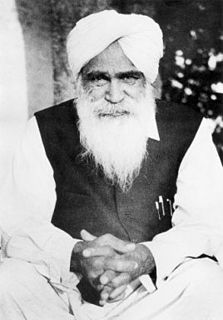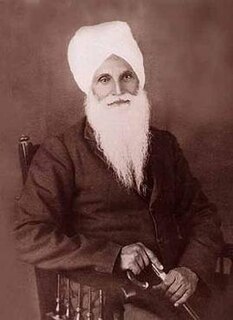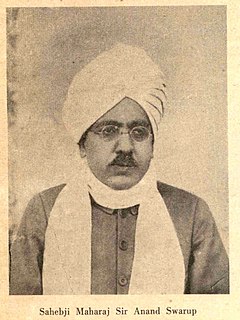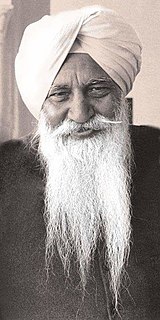The following outline is provided as an overview of and topical guide to spirituality:

Kirpal Singh was a spiritual master (satguru) in the tradition of Radha Soami.
Contemporary Sant Mat Movements, mostly among the Radha Soami tradition, are esoteric philosophy movements active in the United States, Europe, Australia, Latin America, and especially India. These movements assert that Sant Mat shares a lineage with Sikhism and contains elements of thought found in Hinduism, such as karma and reincarnation. They further assert that Sant Mat also contains elements found in Sufism and has inspired and influenced a number of religious groups and organizations. They refer to this spiritual path as the "Science of the Soul" or ‘Sant Mat’, meaning ‘teachings of the saints’. More recently it has been described as "The Way of Life" or "Living the Life of Soul." It incorporates a practical yoga system known as Surat Shabd Yoga.
Surat Shabd Simran is a type of spiritual meditation in the Sant Mat tradition.

Radha Soami or Radhasoami Panth is a spiritual tradition founded by Seth Shiv Dayal Singh Ji in 1861 on Basant Panchami Day in Agra, India.

Shiv Dayal Singh was an Indian spiritual leader. Known among his disciples and devotees by the honorific "Param Purush Puran Dhani Huzur Soami Ji Maharaj", Singh is considered the founder of Radhasoami movement – a 19th-century spiritual faith.

Sawan Singh (1858-1948), also known as The Great Master or Bade Maharaj ji, was an Indian Saint or Sant. He was the second spiritual head of Radha Soami Satsang Beas (RSSB) from the death of Jaimal Singh in 1903 until his own death on 2 April 1948.
Living Master is a term which distinguishes a living spiritual teacher from one who has already left his physical form Certain esoteric spiritual movements, notably Sant Mat and Surat Shabd Yoga, consider a living spiritual adept to be essential, and critique the world religions as mere shells where a living master has been replaced with a scripture, statue, effigy, or other symbol. Just as an example of the current usage, Sant Baljit Singh is described by his disciples as a Living Master, while Jesus Christ or the Buddha are examples of past Masters or Masters out of date as per Sant Mat.
Shabda, is the Sanskrit word for "speech sound". In Sanskrit grammar, the term refers to an utterance in the sense of linguistic performance.

Sir Anand Swarup, Kt. also known as Param Guru Huzur Sahabji Maharaj was the founder of Dayalbagh. He was the fifth revered leader, or Sant Satguru, of the Dayalbagh branch of the Radha Soami faith, who succeeded Sarkar Sahab in 1913. He also laid the foundation of Radhasoami Educational Institute, a co-educational middle school which opened in 1917 and later expanded and developed as Dayalbagh Educational Institute. He wrote many holy books on the Radhasoami faith, explaining the concepts of Surat Shabd Yoga and objectives of Radhasoami in general.
Sant Mat was a spiritual movement on the Indian subcontinent during the 13th–17th centuries CE. The name literally means "teachings of sants", i.e. mystic Hindu saints. Through association and seeking truth by following sants and their teachings, a movement was formed. Theologically, the teachings are distinguished by inward, loving devotion by the individual soul (atma) to the Divine Principal God (Parmatma). Socially, its egalitarianism distinguishes it from the caste system, and from Hindus and Muslims. Sant Mat not to be confused with the 19th-century Radha Soami, also known as contemporary "Sant Mat movement".
Julian P. Johnson (1867–1939) was an American surgeon and author of several books on Eastern spirituality. He spent much of 1932 to 1939 in India, was associated with the Radha Soami Satsang Beas movement and Surat Shabd Yoga, and wrote five books as a result of his experiences.

Hazur Maharaj Charan Singh Ji (1916–1990), was the spiritual head of Radha Soami Satsang Beas, Dera Baba Jaimal Singh, after he was named successor by the preceding Beas guru Sardar Bahadur Maharaj Jagat Singh Ji, in 1951. Maharaj Charan Singh served as the guru for the Beas sangat for almost four decades, until his death from heart failure in 1990 at the age of 73. Before his appointment in 1951, he had practiced law in Hisar and Sirsa, India. He was an initiate of Maharaj Sawan Singh’s, who was his paternal grandfather and the predecessor of Maharaj Jagat Singh. Maharaj Charan Singh assigned the duties of his successor and guru to his initiate and nephew Baba Gurinder Singh.
Advait Mat or Paramhans Advait Mat is a cluster of panths in northern India. It was founded by Shri Swami Advaitanand Ji Maharaj (1846-1919) who is also known as Paramhans Dyal Ji Maharaj. He declared Swami Swarupanand Ji Maharaj as his spiritual successor. Swami Swarupanand Ji Maharaj founded more than 300 ashrams with the purpose of disseminating his master's teachings. Swami Swarupanand Ji Maharaj had initiated more than thousand of his disciples into the sanyas. Many of his disciples went on to establish spiritual institutions to spread the same knowledge.
Jaimal Singh (1839–1903) was an Indian spiritual leader. He became an initiate and later a spiritual successor of Shiv Dayal Singh the Sant of Agra. After his initiation, Jaimal Singh served in the British Indian Army as a sepoy (private) from the age of seventeen and attained the rank of havildar (sergeant). After retirement, he settled in a desolate and isolated spot outside the town of Beas and began to spread the teaching of his guru Shiv Dayal Singh. The place grew into a colony which came to be called the "Dera Baba Jaimal Singh", and which is now the world centre of the Radha Soami Satsang Beas organisation.

Ajaib Singh, also known to his disciples as 'Sant Ji' was born on September 11, 1926, in Maina, Bhatinda district, Punjab, India.

Jagat Singh (1884-1951) was an Indian Surat Shabd Yoga practitioner and initiate of the Sant and Radha Soami Satsang Beas Guru Sawan Singh. He worked as a college chemistry professor at an Agricultural College and was honoured for meritorious service by the British as Sardar Bahadur. After retirement he was chosen by his spiritual Master to be his successor, becoming the third Guru of Radha Soami Satsang Beas. Remembered as quiet, inconspicuous, and unassuming, he was once described by the Muslim mystic Sain Lasoori Shah of Lyallpur as a "perfect disciple" who became a "perfect Master".

Baba Devi Sahab (1841–1919) was one of the leaders of the Sant Mat religious movement, popularizing it throughout North India and Pakistan.
Mastana Balochistani (honorifically known as Shah Mastana Balochistani Ji, was an Indian saint and the founder of the socio-spiritual organization Dera Sacha Sauda in Sirsa. He was originally from Balochistan, and later moved to Sirsa.
This is a list of gurus who gave teachings about the Path of Sound.









